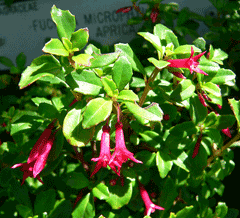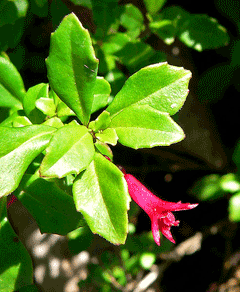 |
|
http://commons.wikimedia.org/wiki/User:Stan_Shebs |
 |
| http://commons.wikimedia.org/wiki/User:Stan_Shebs |
Translate this page:
Summary
Physical Characteristics

 Fuchsia microphylla is a deciduous Shrub growing to 1.8 m (6ft) at a medium rate.
Fuchsia microphylla is a deciduous Shrub growing to 1.8 m (6ft) at a medium rate.
See above for USDA hardiness. It is hardy to UK zone 9 and is frost tender. It is in flower from September to October. The species is hermaphrodite (has both male and female organs) and is pollinated by Insects.
It is noted for attracting wildlife.
Suitable for: light (sandy), medium (loamy) and heavy (clay) soils and prefers well-drained soil. Suitable pH: mildly acid, neutral and basic (mildly alkaline) soils. It can grow in semi-shade (light woodland) or no shade. It prefers moist soil.
UK Hardiness Map
US Hardiness Map
Synonyms
Plant Habitats
Woodland Garden Sunny Edge; Dappled Shade; Shady Edge; East Wall. By.
Edible Uses
Edible Parts: Fruit
Edible Uses:
Fruit - raw. A juicy berry with a nice flavour, but it is usually rather small[K]. The fruit can be up to 1.5cm in diameter according to one report[200], but this is much larger than we have ever seen it[K].
References More on Edible Uses
Medicinal Uses
Plants For A Future can not take any responsibility for any adverse effects from the use of plants. Always seek advice from a professional before using a plant medicinally.
None known
References More on Medicinal Uses
The Bookshop: Edible Plant Books
Our Latest books on Perennial Plants For Food Forests and Permaculture Gardens in paperback or digital formats.

Edible Tropical Plants
Food Forest Plants for Hotter Conditions: 250+ Plants For Tropical Food Forests & Permaculture Gardens.
More

Edible Temperate Plants
Plants for Your Food Forest: 500 Plants for Temperate Food Forests & Permaculture Gardens.
More

More Books
PFAF have eight books available in paperback and digital formats. Browse the shop for more information.
Shop Now
Other Uses
References More on Other Uses
Cultivation details
Succeeds in any fertile well-drained circum-neutral soil[200]. Succeeds in a good loam if sand and leafmold are added[1]. Plants grow best in cool summer conditions with good light[260]. A plant at Heligan gardens in Cornwall is thriving and fruiting well in the fairly deep shade of a woodland garden[K]. This species is hardy in many parts of Britain according to some reports[11, 48], though others say that it is best grown in a greenhouse[1]. A plant growing in a sheltered position outside a greenhouse at Oxford Botanical Gardens seems to be hardy there[K]. Since Oxford experiences lots of frosts and usually some snow in the winter, this suggests that it is possible to grow this species in many parts of Britain, especially if grown against a wall[K]. Plants seem to be immune to the predations of rabbits[233]. A good bee plant[108]. A polymorphic species, a number of sub-species are recognised[11].
References Carbon Farming Information and Carbon Sequestration Information
Temperature Converter
Type a value in the Celsius field to convert the value to Fahrenheit:
Fahrenheit:
The PFAF Bookshop
Plants For A Future have a number of books available in paperback and digital form. Book titles include Edible Plants, Edible Perennials, Edible Trees,Edible Shrubs, Woodland Gardening, and Temperate Food Forest Plants. Our new book is Food Forest Plants For Hotter Conditions (Tropical and Sub-Tropical).
Shop Now
Plant Propagation
Seed - best sown as soon as it is ripe[200] though it can also be sown in the spring[1]. Surface sow the seed in pots in a warm greenhouse and do not allow the compost to dry out[200]. Germination should take place in less than 6 weeks. Prick out the seedlings into individual pots when they are large enough to handle, and grow them on in the greenhouse for at least their first winter. Plant out in late spring or early summer, after the last expected frosts. Inter-nodal cuttings of greenwood, 5 - 8cm long, May/June in a frame. Quick and easy, a high percentage take[78, K]. Overwinter in the greenhouse for the first year and plant out after the last expected frosts. Inter-nodal cuttings of half-ripe wood, July/August in a frame. Very quick and easy, treat as greenwood cuttings above[K]. Cuttings usually succeed at any time during the growing season[K].
Other Names
If available other names are mentioned here
Native Range
NORTHERN AMERICA: Mexico (Chiapas, Ciudad de México, Guerrero, Hidalgo, Jalisco, México, Michoacán de Ocampo, Morelos, Oaxaca, Puebla, Tlaxcala, Veracruz de Ignacio de la Llave) SOUTHERN AMERICA: Costa Rica, Guatemala, Honduras, Panama (north), El Salvador
Weed Potential
Right plant wrong place. We are currently updating this section.
Please note that a plant may be invasive in one area but may not in your area so it's worth checking.
Conservation Status
IUCN Red List of Threatened Plants Status :

Growth: S = slow M = medium F = fast. Soil: L = light (sandy) M = medium H = heavy (clay). pH: A = acid N = neutral B = basic (alkaline). Shade: F = full shade S = semi-shade N = no shade. Moisture: D = dry M = Moist We = wet Wa = water.
Now available:
Food Forest Plants for Mediterranean Conditions
350+ Perennial Plants For Mediterranean and Drier Food Forests and Permaculture Gardens.
[Paperback and eBook]
This is the third in Plants For A Future's series of plant guides for food forests tailored to
specific climate zones. Following volumes on temperate and tropical ecosystems, this book focuses
on species suited to Mediterranean conditions—regions with hot, dry summers and cool, wet winters,
often facing the added challenge of climate change.
Read More
Expert comment
Author
Kunth.
Botanical References
11200
Links / References
For a list of references used on this page please go here
Readers comment
| Add a comment |
|
If you have important information about this plant that may help other users please add a comment or link below. Only comments or links that are felt to be directly relevant to a plant will be included. If you think a comment/link or information contained on this page is inaccurate or misleading we would welcome your feedback at [email protected]. If you have questions about a plant please use the Forum on this website as we do not have the resources to answer questions ourselves.
* Please note: the comments by website users are not necessarily those held by PFAF and may give misleading or inaccurate information.
To leave a comment please Register or login here All comments need to be approved so will not appear immediately.
|
Subject : Fuchsia microphylla
|
|
|
|